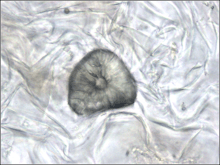Sclereid


Sclereids are a reduced form of sclerenchyma cells with highly thickened, lignified cellular walls that form small bundles of durable layers of tissue in most plants.[1] The presence of numerous sclereids form the cores of apples and produce the gritty texture of pears.
Although sclereids are variable in shape, the cells are generally isodiametric, prosenchymatic, forked or elaborately branched. They can be grouped into bundles, can form complete tubes located at the periphery or can occur as single cells or small groups of cells within parenchyma tissues.
When compared with most fibres, sclereids are relatively short. Characteristic examples are brachysclereids or the stone cells (called stone cells because of their hardness) of pears (Pyrus communis) and quinces (Cydonia oblonga) and those of the shoot of the wax plant (Hoya carnosa). The cell walls fill nearly all the cell's volume. A layering of the walls and the existence of branched pits is clearly visible. Branched pits such as these are called ramiform pits. The shell of many seeds like those of nuts as well as the stones of drupes like cherries or plums are made up from sclereids.
These structures are used to protect other cells.
References
- ↑ Evert, Ray F; Eichhorn, Susan E. Esau's Plant Anatomy: Meristems, Cells, and Tissues of the Plant Body: Their Structure, Function, and Development. Publisher: Wiley-Liss 2006. ISBN 978-0471738435
Further reading
- Mauseth, James D. (2012). Botany : An Introduction to Plant Biology (5th ed.). Sudbury, MA: Jones and Bartlett Learning. ISBN 978-1-4496-6580-7.
- Moore, Randy; Clark, W. Dennis; and Vodopich, Darrell S. (1998). Botany (3rd ed.). McGraw-Hill. ISBN 0-697-28623-1.
- Chrispeels MJ, Sadava DE. (2002) Plants, Genes and Crop Biotechnology. Jones and Bartlett Inc., ISBN 0-7637-1586-7